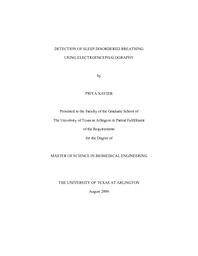
ATTENTION: The works hosted here are being migrated to a new repository that will consolidate resources, improve discoverability, and better show UTA's research impact on the global community. We will update authors as the migration progresses. Please see MavMatrix for more information.
Show simple item record
| dc.contributor.author | Xavier, Priya | en_US |
| dc.date.accessioned | 2007-08-23T01:56:13Z | |
| dc.date.available | 2007-08-23T01:56:13Z | |
| dc.date.issued | 2007-08-23T01:56:13Z | |
| dc.date.submitted | August 2006 | en_US |
| dc.identifier.other | DISS-1446 | en_US |
| dc.identifier.uri | http://hdl.handle.net/10106/177 | |
| dc.description.abstract | This study investigates the application of Electroencephalography (EEG) to detect Sleep disordered breathing (SDB) using power spectral analysis. A preliminary study was performed on 13 subjects (ages: 49.08 ± 8.82) previously diagnosed with OSA. Power spectral analysis was performed and centered on apnea/hypopnea event terminations. The normalized power changes between the frequency bands delta, theta, alpha and sigma were calculated using the Welch Averaging Periodogram method between 10 s of EEG data before the event termination and 10 s of EEG data after event termination. A significant decrease in normalized delta power and a significant increase in normalized theta, alpha and sigma power were observed across the event terminations. The values of the differences in the normalized powers were studied and threshold values corresponding to changes in delta, theta, alpha and sigma bands were chosen. Differences in normalized powers equal to or greater than these thresholds were hypothesized to indicate the presence of event terminations. Power spectral changes were calculated across the EEG signal for the entire night duration by the application of two adjacent 10 s sliding windows moved 5s at a time. Normalized power differences across the sliding windows corresponding to values greater than the threshold values of delta and threshold values of either theta/alpha/sigma were scored as event terminations. These detections were then verified with the EEG signal which had been previously scored by a sleep specialist from an accredited sleep lab and who was blind to the objective of this study. The results showed a good sensitivity (r=0.98) but a number of detections not corresponding to apneic/hypopneic events were observed in both OSA and Control group. These are hypothesized to be due to other cortical activity like RERA's (Respiratory effort-related arousal), transient arousals or K-complexes/spindles which have similar characteristics to cortical arousals. In conclusion, this method proved to be successful in detecting apneic/ hypopneic events but cannot be used as a method to diagnose SDB without further investigation. | en_US |
| dc.description.sponsorship | Behbehani, Khosrow | en_US |
| dc.language.iso | EN | en_US |
| dc.publisher | Biomedical Engineering | en_US |
| dc.title | Detection Of Sleep Disordered Breathing Using Electroencephalography | en_US |
| dc.type | M.S. | en_US |
| dc.contributor.committeeChair | Behbehani, Khosrow | en_US |
| dc.degree.department | Biomedical Engineering | en_US |
| dc.degree.discipline | Biomedical Engineering | en_US |
| dc.degree.grantor | University of Texas at Arlington | en_US |
| dc.degree.level | masters | en_US |
| dc.degree.name | M.S. | en_US |
| dc.identifier.externalLink | https://www.uta.edu/ra/real/editprofile.php?onlyview=1&pid=7 | |
| dc.identifier.externalLinkDescription | Link to Research Profiles | |
Files in this item
- Name:
- umi-uta-1446.pdf
- Size:
- 940.0Kb
- Format:
- PDF
This item appears in the following Collection(s)
Show simple item record


